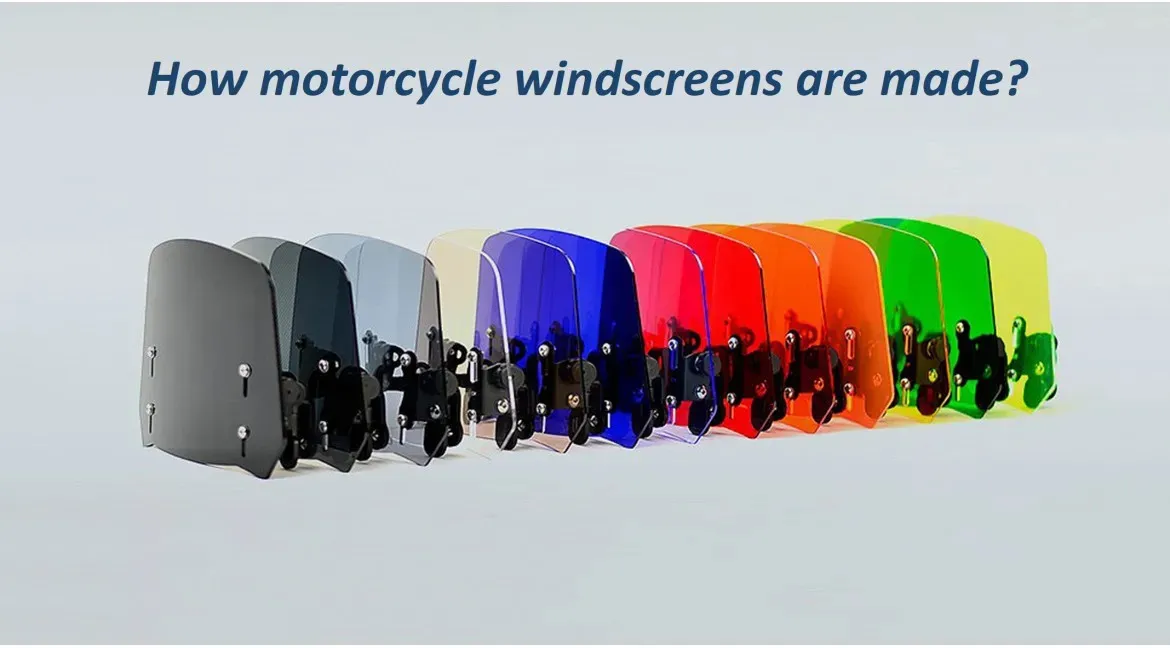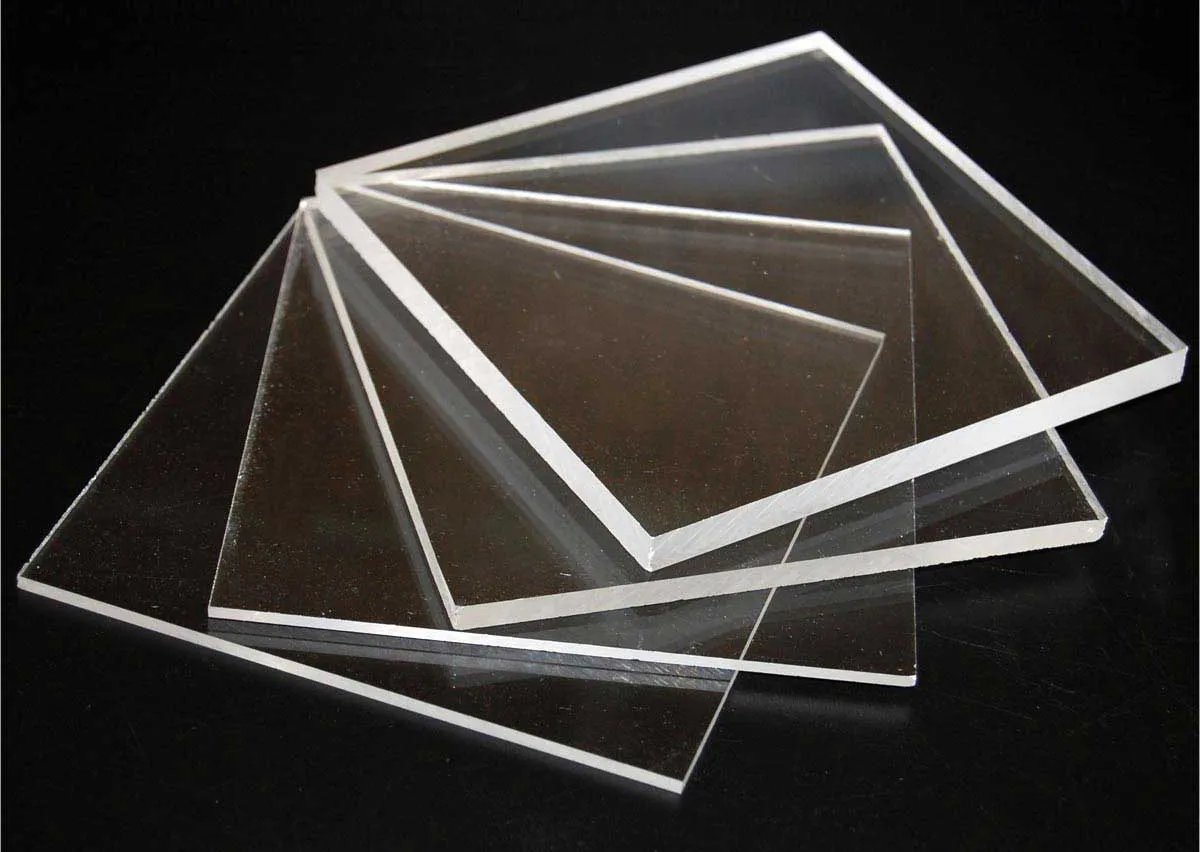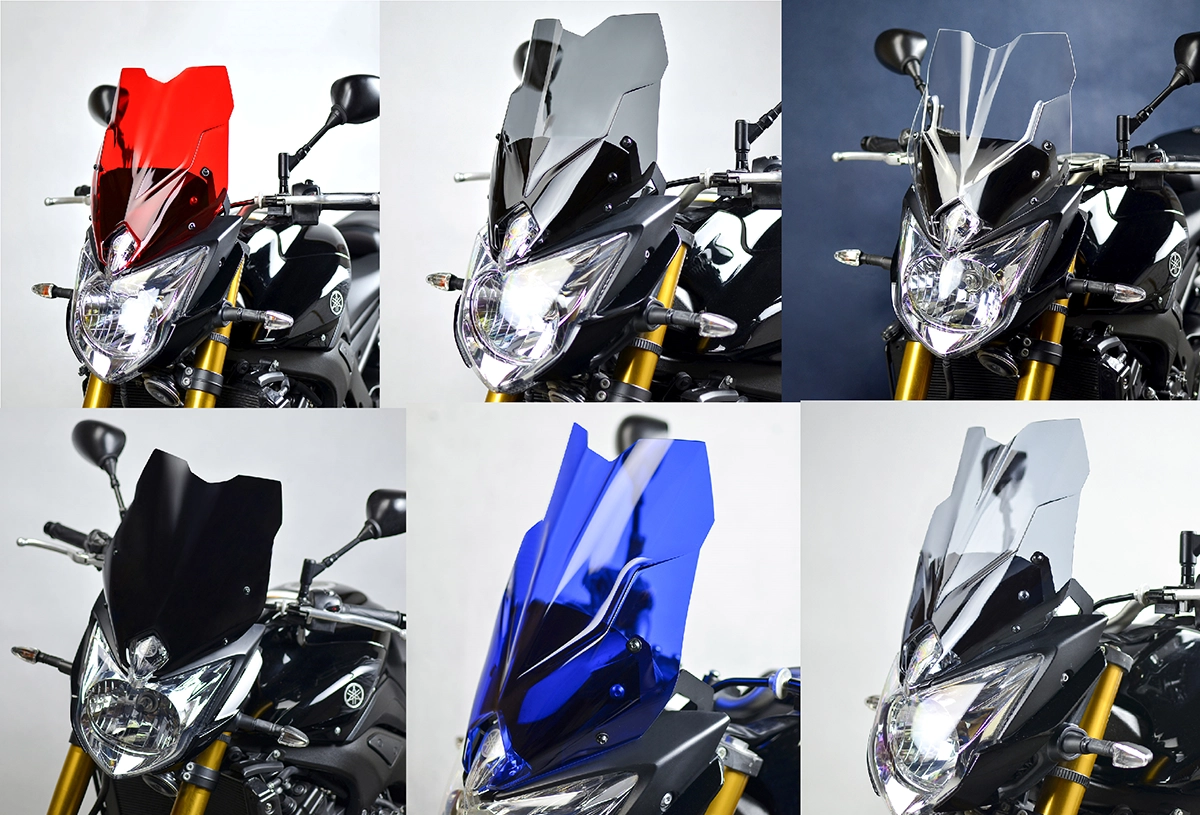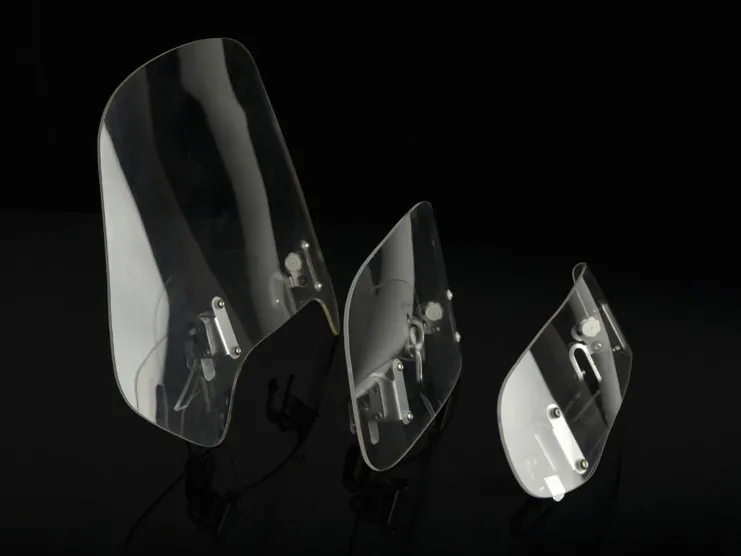
How motorcycle windshields are made?
Table of contents:
How motorcycle windscreens are made?
Motorcycle windshields are one of the most commonly purchased motorcycle accessories, they are mainly used to block the blast of air hitting us while riding, protect us from insects, sand and small pebbles from under the wheels of other vehicles, dust and rain. They also serve as decorative or aesthetic aspect for our motorcycle. Due to the possibility of size, shape and color personalization, there is a huge choice of motorcycle windshields on the market. In order to perfectly match a windshield to our motorcycle, it is worth finding out how such windscreens are manufactured, formed and varnished. Such knowledge will definitely be useful when choosing a manufacturer, material which it will be made of, the right size and thickness to fully meet our requirements.

What are motorcycle windshields made of?
If we think about a transparent piece of material through which we see the world, we usually imagine an ordinary glass used to make windows in our houses, cars etc. However, not many people know that there are better materials with equally good transparency or even better, with much greater strength, susceptibility to forming and bending, and they can be easily tinted in any color. Of course, we are talking about two competitors; acrylic glass called plexiglass, simply “plexi’’ and polycarbonate also called "lexan". In this article, we will answer the question what is motorcycle windshield made of, consider which of these materials is better for the production of motorcycle windshields and we will follow the production process of each of them, as well as indicate their advantages and disadvantages. At the end, we will carefully compare the two materials.
What is the best material for a motorcycle windshield?
To start with, let us present the two most popular materials in more detail:
-
- acrylic glass (plexiglass)
Due to a number of properties that ordinary glass does not have, plexiglass products are of particular interest to customers. Acrylic glass combines most of the elements that their users can expect - durability, good price, safety of use and color personalization. At the beginning, it is worth mentioning the excellent transparency of acrylic glass which provides great experience, because this material does not turn yellow under the influence of sunlight and does not have a greenish shade like traditional glass. Its greatest advantage is practicality, by far. Everyone would like to have a glass that does not break when dropped, that's exactly what acrylic provides. That is why, it works great in the production of motorcycle windshields, resistant to stone impacts from under the wheels of speeding vehicles and easy to clean from sticky insects, dust and dirt. What is more, plexiglass also provides excellent visibility and good protection against blazing sun and car headlights in the case of tinted windscreens. The last feature necessary for motorcyclists is ensuring safety in case of an accident. For example, if a heavy glass windshield as installed instead of a lightweight acrylic one, I dread to think what kind of damage or injuries a broken glass would do to the motorcycle rider.
-
- polycarbonate (lexan)
Polycarbonate is by far the most durable glass-like material - about 30 times more resistant than glass to impact, but a little more fragile to sunlight as it causes yellowing. Unfortunately, unlike acrylic glass it cannot be polished and scratches cannot be removed mechanically. It works well as a material for cold forming, bending without the use of heat, however, it is easily dented. On production halls or as a shield for dangerous machines, it will be perfect because it is not exposed to sunlight, however, as a material for making motorcycle windscreens it will be an average choice due to its yellowing properties and high purchase cost - it is worth mentioning that acrylic windscreens are not cheap, and those made of polycarbonate are evened up to 50% more expensive than acrylic ones. Therefore, the vast majority of motorcycle windshields on the market are made of acrylic glass.

The process of acrylic formation.
Acrylic materials are mainly available in 3 forms: flat sheets, oblong shapes (e.g. pipes) and molding powder. Motorcycle windshields are made by molding already cut shapes from an acrylic sheet. Forming takes place under the influence of temperature, a piece of plastic is heated and then formed. Polymethyl methacrylate is obtained by radical polymerization (the product is an atactic, amorphous polymer) or anionic polymerization (crystalline polymers: isotactic and syndiotactic). Acrylic shapes and plates can be obtained in two ways: First, from finished polymer granules by thermoplastic processing (such as injection molding). The second way is extrusion through a mouthpiece (profiles).
The process of polycarbonate formation.
Because carbonic acid itself is very unstable, polycarbonates are obtained by the polycondensation reaction of phosgene with aromatic diols. Polycarbonate is characterized by resistance to mechanical damage and extraordinary strength, which go hand in hand with ease of processing - shaping, cutting, bending - and transparency. Because of these properties, solid polycarbonate sheets are used as a durable and safe substitute for glass. It is thermoplastic, so we can get objects of many different shapes and sizes out of it. This is why it is so popular in workplaces and places where a very durable transparent glass is required.
How to make motorcycle windscreen?
Producing motorcycle windshields from acrylic glass:
a. You are probably still wondering how motorcycle windshields are actually made? Once we get a ready-made acrylic plate of the appropriate thickness, we use a professional machine to cut out the desired, programmed shape perfectly matching the given type of motorcycle. When a piece of plastic already resembles a motorcycle windshield, it goes to the next stage where it is heated to a temperature that allows us to form it. The length of heating the acrylic sheet depends on the temperature and thickness of the material. The thicker the sheet, the longer it needs to be heated. If the material is heated on one side only, it initially curves upwards. After a while, the glass pane will flatten out again; this means that it is now hot enough to form. During this process, great care must be taken not to overheat the surface as it will produce a network of tiny droplets resembling orange peel which can no longer be removed and effectively deteriorate the perfect transparency of the acrylic glass.
b. After cooling down, the plate is carefully checked and cleaned to verify that there is no scratch or overheating on it. When it meets the standards, it is transferred to the department where mounting holes are drilled in it. The process must be carried out very precisely so that the windshield fits perfectly to the given motorcycle model. After marking the dimensions of the mounting holes by the laser, holes are drilled. After this process, the windshield is gently cleaned again and checked for any unwanted scratches.
c. The final stage is painting (only the windshields that require it). The almost finished product is carefully protected so that the varnish does not get into the wrong places. A special template is applied in order to perfectly cover the windshield with varnish. After this process, the motorcycle windscreen is placed in a special chamber in which no dust or airborne particles will get into the still wet paint. When the windscreen is dry and the varnish hardens, the finished product is carefully checked for the last time for the presence of scratches, overheating and the condition of the varnish. If the product meets the standards, then it is packed in a foam bag with a detailed description of the motorcycle it fits.

Basic differences between acrylic and polycarbonate windshields.
Acrylic motorcycle windshield:
- - is more glossy
- - is available in every possible color
- - is easier to repair scratches on acrylic than on polycarbonate
- - is slightly more transparent
- - does not turn yellow over time and is resistant to UV rays
- - as a material it is easier to cut
- - can be polished to a smooth finish ( How to polish a motorcycle windscreen? )
- - acrylic is not recommended for use in areas exposed to fire or high temperatures
- - small scratches can be removed with a polishing paste
Polycarbonate motorcycle windshield:
- - more resistant to damage than acrylic glass
- - smaller range of colors
- - costs more than acrylic glass
- - is better for drilling or using standard drill bits
- - cannot be polished
- - comes in both rigid and flexible versions
- - prone to yellowing
- - can withstand heat up to 115 Celsius degrees better and is resistant to fire, acids and other chemicals
- - goes well as a material for cold forming, bending without heat but dents easily
- - light transmission is softer which, e.g. protects plants in greenhouses
Why are motorcycle windshields not made of glass?
This is an interesting question because, for example, bonded glass windshields are used in passenger cars, trucks and all kinds of other vehicles. There are many reasons why traditional glass is not suitable for a motorcycle:
- - Safety firstly - in case of an accident, a broken bonded glass pane can hurt us very much because deadly shards of glass will fly towards us which easily stick into the skin, causing painful wounds. In addition, acrylic glass is definitely stronger than traditional glass windshield and more resistant to hitting of pebbles from under the wheels of other vehicles.
- - Another important reason is weight. Imagine how much can weigh a large screen, for example motorcycle windshield for harley davidson made of 5 mm thickness ordinary glass with a metal frame. It can be even additional 20 / 25 kilos! It will definitely make the handling characteristics of the motorcycle worse. Windshields made of acrylic will be definitely lighter (just a few kilos) which will not negatively affect the quality of motorcycle riding.
- - It is also worth mentioning the possibility of personalization. Glass pane cannot be cut or drilled by ourselves, while in acrylic glass it is possible to do it even at home garage. You can even cut the acrylic glass yourself to the appropriate height and sand the edges to obtain smooth sides. The exact process of how to cut the acrylic glass yourself can be found in the main article in paragraph: How to trim a motorcycle windshield?
- - The next issue is the price - the production of glass windshield is definitely more expensive and more time consuming than making it out of acrylic material.
- - Interestingly, acrylic has better light transmission than glass. Glass transmits about 90% and acrylic even 92%. In addition, choosing acrylic material we get good protection against UV rays.
Summary:
We already know the properties of acrylic and polycarbonate, we know how acrylic windshields are made and we have learned the undeniable reasons why motorcycle windshields are not made of traditional glass. There still remains one question that comes to mind when choosing a windshield for our motorcycle - what is the best material for a motorcycle windshield - acrylic or polycarbonate? Everyone should decide for themselves whether they prefer a very durable but prone to yellowing and quite expensive polycarbonate or maybe a little less durable but with perfect transparency, resistance to yellowing and UV rays acrylic material. We hope that this article was helpful and dispelled the doubts but the choice is yours.
Thank you for reading the article and we encourage you to check our motorcycle windshields offer.
If you are considering choosing the perfect motorcycle windscreen for your height, read the article where everything is explained in detail: MOTORCYCLE WINDSHIELDS - EVERYTHING YOU NEED TO KNOW ABOUT THEM!

All comments
A lot of knowledge in one place, I also read about washing the windshield, good job
I'm currently looking for a windshield for Indian Springfield. I was thinking about a polycarbonate windshield, but my previous one was like this and I thought it was normal for it to turn yellow. This time I think I will choose the acrylic one, I hope it will be great. I'll let you know.
Thank you for the article, everything was explained well, now I know which windshield to buy and what to pay attention to. I like to educate myself in various fields, and since I was planning to buy a windshield for my Kawasaki, I thought I would delve deeper into the topic. Thanks